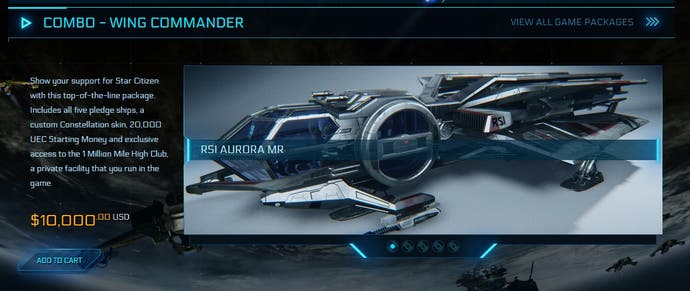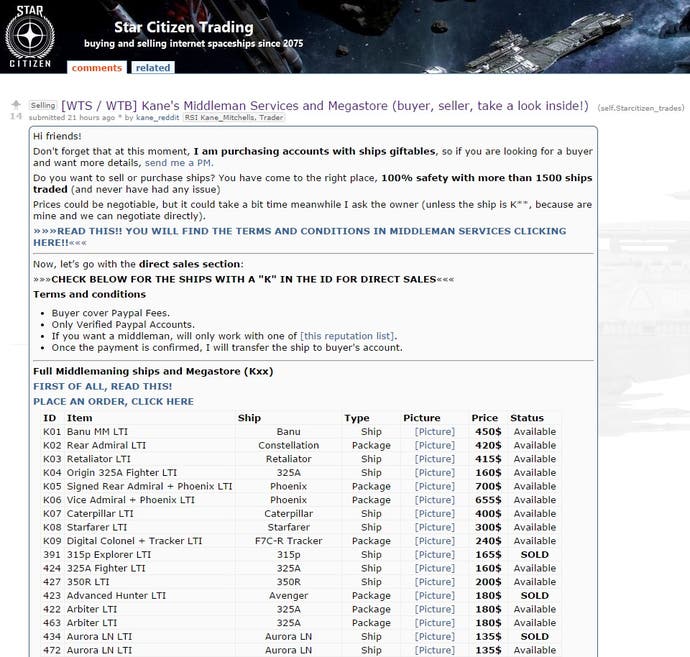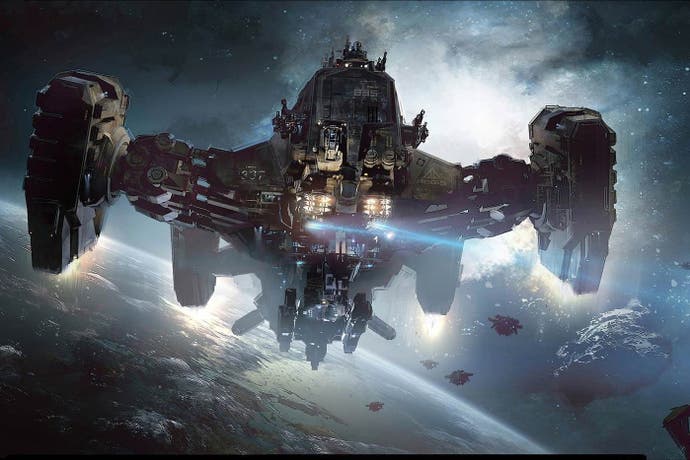Inside Star Citizen's grey market
People are spending thousands of pounds on virtual spaceships for an unfinished game. We investigate.
"Kane" won't tell me how much he's made as a Star Citizen middleman. Like so many Spaniards affected by the economic crisis, he was recently made redundant, but the bills keep on coming. "These transactions are helping me in these difficult times," he says.
These days, the second-hand sale of virtual goods is a tired story. But what makes Star Citizen's grey market special is that in many cases the spaceships that are bought and sold can't be used in the game yet. They're just £1000 ideas, the promise of that most base fantasy: exploring the galaxy in your very own - and very exclusive - spaceship. Kane is just one of many making money out of a grey market fuelled by that promise - and it exists underneath the covers of Star Citizen's gargantuan success.
Star Citizen is one of the more fascinating video games in development right now. It's a hugely ambitious space simulation driven by a massively multiplayer online persistent world with a first-person shooter portion and a single-player story bolted on. It's also a poster child for graphics-card-melting PC gaming, looks the business and is made by one of our favourite sons: Mr Wing Commander himself, Chris Roberts.
When it comes to headlines, though, you'd be forgiven for thinking Star Citizen was all about the money. Its Kickstarter ended in November 2012 with an impressive $2.1m raised, but the money keeps rolling in. There's a ticker on the Star Citizen website that tells us just how much money. We can even see developer Cloud Imperium Games' coffers swell in real-time. At the time of publication an incredible $56m had been raised - a figure that has scored Star Citizen the Guinness World Record for the most amount raised by a crowdfunded project of any kind ever.
How is this possible? Why do people keep throwing money at Star Citizen?
Because of virtual space ships.
Star Citizen's "in-universe" store sells many ships for use in the game. They range in price. The $45 Arena Commander Starter package includes immediate access to the dogfighting module as well as the Aurora MR ship. But there are scores of more elaborate ships and packages available, and some are pretty expensive.
The Anvil Hornet costs $110, for example. The Constellation Andromeda, a multi-person freighter, costs $225. On the other end of the scale is the $10,000 Wing Commander Combo. This includes all five pledge ships, a custom Constellation skin, 20,000 UEC starting money (that's the in-game currency) and exclusive access to the 1 Million Mile High Club, a private facility that you run in the game. Oh, and you also get a day with Chris Roberts.

While the official shop lets players buy ships from Cloud Imperium Games, players can't officially sell ships to each other. Enter the Star Citizen grey market.
The Star Citizen grey market emerged out of a couple of important design decisions by CIG. One, the developer sells certain ships for a limited time or in limited numbers, creating a demand for products that aren't available to all players at all times. Two, in the final game your ships can be destroyed. The answer? In-universe insurance that protects players' investments. It's clear that when it comes to Star Citizen's virtual spaceships, the stakes are high.
"In the beginning it was very simple," Star Citizen grey market expert and occasional middleman Sean "Drevan" Smith tells me.
You were considered a Star Citizen trader if you had a ship to sell to someone for real world cash - and there were plenty of potential customers. To accommodate this demand players began listing their wares on Reddit and eBay. Some even set up their own auction house websites. Everything had a markup, of course. Money had to be made.
Typically, you would advertise your desire on the Star Citizen Trading sub-Reddit, pay money, usually through PayPal, to someone who answered your call, and through the in-game gifting system an exchange was made. Simple. Now though, the market is much more complicated.
Currently CIG sells ships with insurance that lasts only for a set period of time, for example six months. This insurance ensures your ship will be replaced and its modifications and cargo will be subsidised should it be destroyed in a fight or an accident. The idea is that in the final game, insurance policies must be maintained, so players will have to pay a regular fee in galactic credits to avoid a policy lapse.
In the early days of Star Citizen, backers received ships with lifetime insurance (LTI, as it's known by players), which effectively protects investments forever without the need for payments. But in November 2012 CIG stopped selling ships with LTI to newcomers. 12 months later it stopped selling ships with LTI to all players. This, as you'd expect, created a huge demand for those ships that had it.
According to Drevan, it was this change around LTI that caused Star Citizen trading to skyrocket.
November 2013 was a huge month for CIG and Star Citizen saw an influx of new players. Many of those newcomers were jealous of those who had ships with LTI and were willing to pay a premium to get hold of them. Traders, their eyebrows raised by this new potential for profit, put exclusive pledge packages up for sale with huge markups of between 30 and 400 per cent of the original cost.
Drevan tells me of one high-profile example of this. The Vanduul Scythe, coveted and infamous within the Star Citizen community, is a ship originally sold by CIG for $300 during the Kickstarter campaign. It came with LTI included and only about 500 were ever given out to players. It is no longer for sale. Half a year ago they were selling "like hotcakes" for, wait for it, $2000 each.
Let's step back for a minute. The Vanduul Scythe is a virtual spaceship with virtual insurance that you can't use in the game yet. You can't fly it in the Arena Commander module. You can't admire it in the Hangar module, your spaceship garage. If you own it, you own the idea of flying the Vanduul Scythe around the finished game - a game, by the way, that won't be feature complete until 2016. I think Chris Roberts and his chums at CIG are geniuses.
Drevan had wanted to pledge to Star Citizen during its Kickstarter phase, but missed the 19th November 2012 deadline. For months afterwards, CIG still allowed pledges through its website, so Drevan went on what was, by his own admission, a spending spree, splashing out $600.
"There was something enticing about the Vanduul Scythe," he remembers. "I did some research into possible ways to get one, in-game and out. I stumbled upon the Star Citizen Trades Reddit. It was then that I made a decision, that I would sell all the pledges that I paid for and trade until I could afford my own Vanduul Scythe."
It took Drevan three months of trading to generate enough profit to buy a Vanduul Scythe for $1500. He even had enough cash spare to get all his original pledges back through the official shop on the Roberts Space Industries website.
Now, though, Drevan dabbles only occasionally in Star Citizen trading, preferring to keep a close eye on the economy from a distance. There are those who are involved much more deeply, he says, before pointing me towards the most infamous Star Citizen middleman around: Kane.

Kane's Middleman Services and Megastore lists scores of Star Citizen ships that are for sale, along with their prices. Yes, the Vanduul Scythe is there - at the time of publication yours for a cool $1700.
I track Kane down over email, which he prefers because English is his second language. He tells me he came to Star Citizen late, in September 2013, so was not an original backer, but he was entranced. And there was one ship that caught his eye: the Freelancer with, of course, LTI, but he couldn't afford it. So he watched the already established grey market intently, waiting for the ship to pop up for sale. It was while he was watching that he had a thought.
There was a thread where a player, he remembers, was selling an Arbiter and an Avenger. A couple of threads below was another player who wanted to buy those exact ships. So, Kane bought them from the first guy and sold them to the second guy. He made $30, or, as he puts it to me: "I was $30 closer to my beloved Freelancer."
Kane founded his Megastore in December 2013 after he became overwhelmed with the number of ships he was buying and selling. The idea was it would be a familiar and safe place for people to buy ships with LTI, updated every day with new deals. It only took a few days for Kane's reputation to precede him. His appeal, he says, is the result of good old-fashioned customer service, transparency and security. "I always help them," he says, "answering their questions, making the transactions fast and easy."
Star Citizen trading exploded, but as it did it caught the eye of nefarious internet operators. Scam artists became a real problem, taking money paid into PayPal accounts then doing a runner. As more and more trades were made, more and more scams were reported. It was an awkward time: CIG didn't want much to do with disgruntled players burnt by trading virtual goods outside of their game, and the disgruntled players wanted their money back. Something had to give.
In April 2014 CIG announced plans to change its gifting system so packages could only be gifted once. Here's the relevant point:
"In order to eliminate the middleman scam, packages will be giftable only once before they are locked to an account."
In short, if an item is traded once, it can't be traded again. On 1st May the changes kicked in. That was that, many thought. Star Citizen trading was over.
Not so. The grey market found a way to continue. Star Citizen middlemen survived by deftly changing tack. Before the change, middlemen managed ships. Now, they manage the money.
"My main objective as a middleman is to offer safe transactions, both to buyers and sellers," Kane says. And for this service middlemen charge a fee. Kane says when CIG imposed limitations on Star Citizen's gifting system, it removed an important defence against scams. Buyers and sellers must contact each other directly in what are, essentially, blind transactions. "Please, don't misunderstand me, I understand perfectly, and support CIG and this measure because they have reduced the possibility of scams long-term," Kane says, "but short-term it will be easy for the scammers to get the money and run."
Now, Kane offers safe transactions from a ship showroom bolstered by a superb reputation among the Star Citizen trading community. Sellers list ships in Kane's Megastore safe in the knowledge that any transactions will be free from the clutches of scammers. Buyers know all ships are verified. In Kane's Megastore, everyone wins. He sells peace of mind.
Here's how it works: when Kane is contacted by a buyer or seller he verifies their identity. Once he's satisfied they're trustworthy, he lists the ship or ships in the store or begins the sale transaction. The buyer pays Kane for the ship. Kane sends the seller a message, asking them to send the ship to the buyer. Once both parties confirm the ship is sent, Kane pays the seller. All the while he is taking screenshots and saving registries and documents. He has a direct line to an in-game Concierge (part of a select group of Star Citizen players whose questions, requests and needs are answered by an on-staff human being) if there are any problems. "I have not had any problems," he says. "The system works fine," he says.
"Most customers are legit and just want to get some money for their ships for different reasons (medical issues, car damaged, profit for a new game, etc.), and they only want a safe place to sell or buy ships," Kane says.
Kane has managed nearly 400 transactions as a Star Citizen middleman and sold more than 1300 ships directly. He says on average he manages five transactions a day. The most expensive transaction he's managed was for an Idris-M, a frigate no longer available to buy (he won't say how much it went for because he doesn't want to "mark" a ship sold on his Megastore with any specific value). But the Idris-M usually goes for $4000, Kane notes, before saying he knows people who spent more than €15,000 on LTI ships when they were available in the hope they would be able to sell them for a profit. Right now, that's exactly what they're doing.
Right now, the Star Citizen grey market is in a state of balance. Real-world money is changing hands as virtual space ships go back and forth. But it is middlemen who are the glue that holds the grey market together, protecting players from scams, ensuring deals are done despite the restrictions on gifting. Things, it seems, are working well, and the economy is purring along nicely.
Soon, though, things will changes once again, with the return of lifetime insurance.

A middleman who asks to be called "Nigel" tells me of CIG's plan to sell six new ships, each with LTI. When a ship's concept gets final approval from Chris Roberts, they will be sold in a one-week concept-only sale. After that week ends, the ship will not be available for sale until it is ready for use in the Hangar. Yes, you read that right: CIG is selling concept versions of virtual spaceships that can't be flown or even viewed in a game that isn't finished. In fact, the first of these, the Aegis Reclaimer, went on sale last week - for $350.
In its announcement CIG acknowledged that the preservation of lifetime insurance was "one of the most common demands" from players. Its stance is that LTI is a "slight convenience and not a game changer". Still, as the grey market shows, everyone's mad for LTI. And as a result everyone will go mad for these concept ships.
"We feel comfortable including it [LTI] during concept sales of ships which have never been available before (and do not intend to make it available again for existing ships or variants)," CIG added.
"CIG has constantly said it's not going to be worth much in the game, yet people don't seem to believe that and will happily spend at least an extra $100 to obtain an LTI version of a ship on the second-hand market," Nigel, who claims to have made £2000 in a few months off the back of Star Citizen trading, says.
"Plenty of traders here will be stocking up on the new ships, sitting on them for a while and then selling them later for a significant profit."
I meet Chris Roberts in a busy booth in the business centre of Cologne's gargantuan Koelnmesse. It is Gamescom week, and the morning before an evening during which Roberts will premiere new features for Star Citizen to an army of expectant fans. The booth is a hubbub of excitement. CIG staff are prodding builds on powerful PCs, checking they work, then checking again. There's a new spaceship race mode that Roberts shows me. He pilots using what looks like a sci-fi cockpit strapped to a desk, racing one of his colleagues, who, clearly, is the faster pilot, weaving in and out of rings over an angular, clean-cut city skyline. The colleague sets a decent time, with Roberts languishing somewhere far, far behind. Rule number one, I think: never destroy the boss at his own game.

To my right is the largest television I've ever seen. Roberts enthuses about the display, and how good Star Citizen looks in a 4K resolution. He shows me a trailer that stars some quirky aliens on a mysterious planet. Most of Star Citizen's promotional videos are "in universe" - that is, they are make-believe spaceship adverts made by make-believe spaceship manufacturers. "Buy me," they whisper in dulcet tones that drip with the juice of a thousand crushed strawberries. "You know you want to."
On the wall is a poster of four new ships Roberts will announce that evening: all Constellation class. These huge virtual space ships are special because they let more than one player work their innards. They require a crew to work.
In fairness, Star Citizen's ships are incredibly detailed. Players tell me they're well worth the money, even if most of us would frown upon such extravagance for what is, essentially, bits of code. But Star Citizen stands out for me because it's selling spaceships that are unfinished, and, as a result, can't be used in the game.
The Arena Commander module is a player-versus-environment bubble in which players shoot enemy ships. That's available to play right now, but it only includes certain ships. The Hangar is a virtual showroom for your ships. That, too, is available now, but, again, only includes certain ships. Star Citizen's persistent universe is where the game will open up, allowing all ships to spread their incredibly detailed wings and fly. But the persistent universe does not exist yet, and so Star Citizen's most elaborate spaceships are grounded - for now. But they can still be bought and sold.
"Yes, not all the ships are in the hangars or in Arena Commander currently," Drevan says. "It's really no different than any other crowdfunding project that I have seen to date. People donate to see a promise made into reality. Chris Roberts and his team have done a fantastic job of pitching their dream and it happened to be exactly what many fans of space sims wanted.
"One thing very unique to Star Citizen is that they have a fairly open development, so they are constantly giving updates on progress, polls to find what features pledgers want, and they converse quite openly with the community. People respond quite well to that and it definitely shows. They have been fairly quick in updating and adding new features to the Hangar Module and Arena Commander. Each update brings in new additions and ships are added to the modules often."
What kind of person buys a virtual space ship they can't even use? The Star Citizen community, I find, is passionate, involved, and, generally, has a bit of money to spend on what they feel will be an all-encompassing hobby.
"I would say they are very hungry," Drevan says. "Hungry in the sense that they want to play Star Citizen badly and be prepared for every scenario they come across in the persistent universe. The majority of them are also older - generally over 25 - from my experiences. I've met and traded with many already retired or nearing retirement."
"They are people like you and me," Kane says, "fans of Star Citizen who want to have the ships they like the most and want the maximum customisation for their account. They love the game and want to enjoy the 'perfect experience' for each of their ships."
Nigel has another theory: "I think most believe it will give them an advantage in the game and that they wouldn't be selling the ships for so much if they weren't somehow worth it. They'll do that while being vocal in the belief that the game won't be pay to win."
If you think it's all about the money or some perceived eventual in-game advantage, think again. An MMO community manager friend tells me a story of a wealthy benefactor who buys incredibly expensive ships from the official store while they're on sale, then gifts them to players who can't afford them.
Drevan points to the Aegis Dynamics Gladius, a ship that was sold a few months ago for just a week. Mysterious benefactors bought the ship in bulk, waited a month then posted them up for sale for the original cost plus the PayPal fee, waiving the chance to make a profit but helping those who missed out on what became a rare, coveted package.
And Kane has helped sellers who have bought ships or packages just to give away to friends or their children. "I have helped manage surprise to husbands and wives," he says.

When I quiz Chris Roberts on the sale of these ships, their cost and who buys them, he has a rapid-fire response. "It's a bit of the future," Roberts says in his curious accent. The Manchester-born designer's northern twang has been remastered with a Hollywood lick of paint to produce a sound I imagine adapts to its environment. When he's talking to his brother, Erin, who is sat near us, in private, I bet the Manchester rock-and-roll band takes centre stage. But when he's talking to a movie producer in LA, I bet it hides behind the curtain. For some reason I think of Sting, Joss Jones and Peter Moore.
"Is it any different than when you go to Comic-Con and you buy your special character models or vehicle models?" he continues. "There are quite a few people who are now at the point where the model is detailed enough that they like the digital version of it, because they don't have the shelf space. Some people like that sort of digital collecting."
"Things are changing," says Roberts. "The traditional feeling is, you want a physical thing, and then that's got value. But the ships we build, it costs hundreds of thousands of dollars to build a ship at that level of detail and put it in there. Is that different than hundreds of thousands of dollars spent manufacturing those old plastic models? I don't know. Some people, they do see some value on the digital side in a way, old-school thinking about it, you wouldn't."
Collecting has been a part of video games since day one. It is an enduring, central part of their appeal. We like to have things lined up next to each other, preferably in a cabinet, but a shelf will do. We collect things in video games and we collect video games. We collect virtual space ship models in Mass Effect to pop in our captain's quarters as we collect the Mass Effect series of games. Star Citizen is like the ship collecting in Mass Effect, except, well, bigger.
"Some people just like the idea of looking in their hanger, their space garage, and looking at their collection of ships," Roberts says. "There's a sense of pride. The same way if a rich person buys a bunch of sports cars. They can't really drive every one of their Ferraris or Porches. Jay Leno has got warehouses full of cars, right? He's got so many cars he could drive a different car every day of the year and go three or four years and not drive the same car. How useful is that, really? He just likes to collect them. If people collect comics, most people don't read those comics they're collecting. They just have this huge comic collection."
We've come full circle. We play video games because we desire the immersion of the virtual world, to lose ourselves within it, to live out a fantasy. And we buy and gawp at Star Citizen's virtual space ships - many of which can do nothing but sit in a pretend hanger - because it's "in universe". This, we think, is better than playing with toys on our bedroom floor. This is playing with toys, evolved.
The traders I spoke to reckon the people at CIG know exactly what they're doing. Indeed the way they sell the ships is, the traders say, the reason the grey market exists in the first place. By selling certain ships only in limited numbers and selling others only for a short period of time, CIG has created a market for products only some people can have. There is a limited supply and a high demand. "I think people will be studying CIG marketing practices for a long time to come," Nigel says.
During our chat Chris Roberts expresses no desire to clamp down on the Star Citizen grey market ("That's amazing to me"). In fact, the way he talks, it sounds like it'll only get bigger once Star Citizen launches proper.
Here's his vision, as he explains it to me: When the persistent universe is up and running, ships will be manufactured from shipyards, then sold and traded to other players in universe. Some of these ships will be highly coveted because they are rare, or expensive, or take a lot of time and effort to produce, such as a cruiser. There will be players who simply have to have that cruiser right now, but there won't be one coming out of the shipyard for, let's say, a month. Those players may want to do a deal with a player who owns that cruiser - for the right price. "But that would be cool," Roberts says. "That's what happens in the real world.
"The whole goal is to be able to have a lot of trading and e-commerce inside the game. We have a dynamic economy. If you have tools in there for the players to buy, sell, create jobs, work for other people and build their own empires, it's better for you. Otherwise you always have to provide the content. But if the players are doing half of this stuff for you you can focus on things that matter.
"Eve Online does a pretty good job of having a lot of player generated content drive the drama of the universe. I'd like to have the tools to be able to allow the players to do a lot of that; create missions for each other, take over a part of the galaxy or build up a trading empire, and then we focus on expanding the universe, creating more locations for people to explore or trade, more ships to fly around in. And then occasionally some narrative stories in there. That would be the best balance and that's the model we're going for."
Roberts' vision for all of this is that it occurs inside the game - on in-universe. But really we shouldn't be surprised that Star Citizen trading has already established itself outside of it. By manufacturing the rarity of these ships CIG has inflated their perceived value.
Perceived is the operative word here. Unlike say, CCP's Eve Online, which has a working, well-established universe in which players invest a huge amount of time gathering resources in order to manufacture ships that can be used, right now, in huge space battles or to fuel a complex game of virtual politics, Star Citizen currently trades off of pie in the sky economics. Until the persistent universe is up and running, there are no game mechanics involved in determining the rarity of ships. They're rare because CIG says they are.
"It's kind of cool in the fact it's real-world economics at work," Roberts says of Star Citizen's grey market.
"But it wasn't intentional. It fell out of something we did as a creative design decision to make sure the persistent universe isn't unbalanced."
For now, then, Star Citizen's grey market rumbles on, services such as Kane's Megastore continue to thrive, and the money keeps on flooding into CIG's coffers. The Roberts Space Industries website tracker shows how much money is being made on an hourly basis. I'm looking at it now and in the last hour players spent $6836. On 27th September 2014 $451,701 was made. For the whole of September just over $2.7m boosted the bank balance. Roberts tells me Star Citizen will be finished - in that it'll be feature complete and stuck together to form a cohesive whole - at some point in 2016. I remember a video game developer once telling me it may be in Roberts' best interest never to release Star Citizen, the way things are going.
"The party has to end sometime," Nigel says. "But the game seems a long way off, so I expect things to last."
















